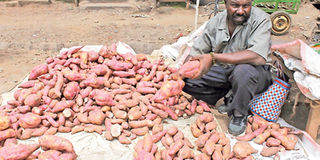Agronomist notebook: Why some sweet potato tubers have black marks

Peter Kihiko sorts sweet potatoes for sale in a a market in Elburgon. After harvesting and sorting the potatoes, grading should be done as infected tubers act as a source of infections to the unaffected tubers. PHOTO | JOHN NJOROGE | NATION MEDIA GROUP
What you need to know:
- While the tubers looked attractive from far, a closer look showed they had tunnels and black marks making them unsaleable. Some consumers never mind and eat the tubers, but such sweet potatoes usually have a bitter taste.
- The infested tuber often has tunnels that serve as entry points for infections making them bitter and sometimes they rot.
- Timely planting is also ideal, as this reduces pest infestation since one harvests the tubers early enough before the ground cracks to allow the penetration of the weevils into the soil and tubers.
- After harvesting and sorting, grading should be done as the affected tubers act as a source of infections to the unaffected tubers.
Sweet potatoes are farmed in many parts of the country under irrigation or rain-fed because of the crop’s adaptability.
I recently encountered a vendor who was selling the produce at the Nakuru Town market. The trader had very huge sweet potatoes that any consumer would cherish to have, but they had some blemishes.
A kilo was retailing at Sh50 and under good management practices, one acre can produce up to 15-20 tonnes, making the crop profitable.
While the tubers looked attractive from far, a closer look showed they had tunnels and black marks making them unsaleable. Some consumers never mind and eat the tubers, but such sweet potatoes usually have a bitter taste.
The tunnels and black marks are an indication that the sweet potatoes have been affected by weevils. This is the most common pest affecting the crop, causing the most destruction to the tubers.
Normally, adult weevils feed on the leaves and the vines of the sweet potatoes in the vegetative stage. The leaves then turn yellow, an indication of the weevil infestation.
They also lay eggs on the leaves and vines and once the crop starts forming the tubers, the weevils spread their attack.
They normally search for the exposed roots and get into tubers through exposed cracks since they cannot dig into the soil. Infestation of the tubers thus depends on the availability of the cracks in the soil.
As they feed on the tuber, they lay eggs below the surface of the roots. In young plants, damage caused by the weevils’ results in high mortality cases.
The infested tuber often has tunnels that serve as entry points for infections making them bitter and sometimes they rot.
The vines also become thick, malformed and tend to discolour, crack and wilt. To control the pest, farmers should create mounds or ridges incorporating fresh lantana camara leaves before planting the sweet potatoes vines.
This improves soil organic matter and at the same time serves as a repellent of the sweet potato weevil. The yields and the quality of the tubers are thus increased.
FIELD SANITATION
Farmers should also have an effective crop rotation programme with cereals and forage crops. It’s also important for farmers to source for clean planting materials that are not affected by the pest. One should also plant resistant varieties.
Deep planting is also ideal, and one should regularly fill the soil cracks around the plants. Early maturing cultivars are also less prone to infestation as compared to late-maturing ones. Irrigation helps in reducing the soil cracks.
Newly planted vines should be mulched as this helps to prevent cracks, and provide a conducive environment for the natural enemies. Intercropping the sweet potatoes with ginger or coriander helps considerably in controlling the pest.
Timely planting is also ideal, as this reduces pest infestation since one harvests the tubers early enough before the ground cracks to allow the penetration of the weevils into the soil and tubers.
Field sanitation should also be observed by removing and burying the affected crop before the next crop is planted. Timely harvesting should be done to prevent the infestation
After harvesting and sorting, grading should be done as the affected tubers act as a source of infections to the unaffected tubers.
Other pests affecting the crop include millipedes and the root-knot nematodes. The crop is also not spared by diseases as it is attached by sweet potatoes scurf where the roots develop dark brown to black spots. The scurf lesions enlarge when the sweet potatoes are stored.
High rainfall and high humidity create a conducive environment for the growth of fungal diseases. Polluted soil and storage points also result in contamination of the tubers.
Control diseases using clean planting materials that do not have the sweet potatoes scurf. Also ensure that the soil does not have too much organic matter as the diseases become more severe. Animal manure should thus be reduced.
Copper-based fungicides can be used to control the diseases, but these should be used as the last option.





